SF6 Tracer Technique to Estimate Methane Emission in a Dual-Flow Continuous Culture System: Test and Application
Abstract
1. Introduction
2. Materials and Methods
2.1. Experiment 1—Experimental Design
2.2. Experiment 2—Experimental Design
2.3. SF6 Permeation Tube Preparation and Collection Canister
2.4. Dual-Flow Continuous Culture System
2.5. CH4 and SF6 Analyses
2.6. Statistical Analysis
3. Results
3.1. CH4 and SF6 Analyses
3.1.1. Experiment 1
3.1.2. Experiment 2
4. Discussion
4.1. SF6 Marker to Estimate CH4 Emissions in DFCCS
4.2. Effects of the Partial Replacement of SBM with Algae Biomass
5. Conclusions
Author Contributions
Funding
Institutional Review Board Statement
Informed Consent Statement
Data Availability Statement
Acknowledgments
Conflicts of Interest
References
- Bashmakov, I.; Nilsson, L.; Acquaye, A.; Bataille, C.; Cullen, J.; de la Rue du Can, S.; Fischedick, M.; Geng, Y.; Tanaka, K. Climate Change 2022: Mitigation of Climate Change. Contribution of Working Group III to the Sixth Assessment Report of the Intergovernmental Panel on Climate Change; Lawrence Berkeley National Laboratory: Berkeley, CA, USA, 2022. [Google Scholar]
- Beauchemin, K.A.; Ungerfeld, E.M.; Eckard, R.J.; Wang, M. Review: Fifty Years of Research on Rumen Methanogenesis: Lessons Learned and Future Challenges for Mitigation. Animal 2020, 14, s2–s16. [Google Scholar] [CrossRef] [PubMed]
- Gerber, P.J.; Hristov, A.N.; Henderson, B.; Makkar, H.; Oh, J.; Lee, C.; Meinen, R.; Montes, F.; Ott, T.; Firkins, J.; et al. Technical options for the mitigation of direct methane and nitrous oxide emissions from livestock: A review. Animal 2013, 7 (Suppl. 2), 220–234. [Google Scholar] [CrossRef] [PubMed]
- Subepang, S.; Suzuki, T.; Phonbumrung, T.; Sommart, K. Enteric methane emissions, energy partitioning, and energetic efficiency of zebu beef cattle fed total mixed ration silage. Asian-Australas. J. Anim. Sci. 2019, 32, 548–555. [Google Scholar] [CrossRef] [PubMed]
- Tedeschi, L.O.; Abdalla, A.L.; Álvarez, C.; Anuga, S.W.; Arango, J.; Beauchemin, K.A.; Becquet, P.; Berndt, A.; Burns, R.; De Camillis, C.; et al. Quantification of methane emitted by ruminants: A review of methods. J. Anim. Sci. 2022, 100, 197. [Google Scholar] [CrossRef]
- Makkar, H.P.S.; Vercoe, P.E. (Eds.) Measuring Methane Production from Ruminants; Springer: Dordrecht, The Netherlands, 2007; ISBN 978-1-4020-6132-5. [Google Scholar]
- Johnson, K.; Huyler, M.; Westberg, H.; Lamb, B.; Zimmerman, P. Measurement of methane emissions from ruminant livestock using a sulfur hexafluoride tracer technique. Environ. Sci. Technol. 1994, 28, 359–362. [Google Scholar] [CrossRef]
- Berndt, A.; Boland, T.M.; Deighton, M.H.; Gere, J.I.; Grainger, C.; Hegarty, R.S.; Iwaasa, A.D.; Koolaard, J.P.; Lassey, K.R.; Luo, D.; et al. Guidelines for Use of the Sulphur Hexafluoride (SF6) Tracer Technique to Measure Enteric Methane Emissions from Ruminants; Ministry for Primary Industries: Wellington, New Zealand, 2014; p. 166. [Google Scholar] [CrossRef]
- Poteko, J.; Schrade, S.; Zeyer, K.; Mohn, J.; Zaehner, M.; Zeitz, J.O.; Kreuzer, M.; Schwarm, A. Guidelines for Use of SF6 Tracer Technique to Measure Enteric CH4 from Ruminants, 2nd ed.; Jonker, A., Waghorn, G., Eds.; Ministry for Primary Industries: Wellington, New Zealand, 2020; ISBN 978-1-99-004337-6. [Google Scholar]
- National Research Council (US) Committee for the Update of the Guide for the Care and Use of Laboratory. Animals Guide for the care and use of laboratory animals. In The National Academies Collection: Reports funded by National Institutes of Health, 8th ed.; National Academies Press: Washington, DC, USA, 2011; ISBN 0309154006. [Google Scholar]
- Yáñez-Ruiz, D.R.; Bannink, A.; Dijkstra, J.; Kebreab, E.; Morgavi, D.P.; O’Kiely, P.; Reynolds, C.K.; Schwarm, A.; Shingfield, K.J.; Yu, Z.; et al. Design, implementation and interpretation of in vitro batch culture experiments to assess enteric methane mitigation in ruminants—A review. Anim. Feed Sci. Technol. 2016, 216, 1–18. [Google Scholar] [CrossRef]
- Brandao, V.L.N.; Marcondes, M.I.; Faciola, A.P. Comparison of microbial fermentation data from dual-flow continuous culture system and omasal sampling technique: A meta-analytical approach. J. Dairy Sci. 2020, 103, 2347–2362. [Google Scholar] [CrossRef]
- Wenner, B.A.; de Souza, J.; Batistel, F.; Hackmann, T.J.; Yu, Z.; Firkins, J.L. Association of aqueous hydrogen concentration with methane production in continuous cultures modulated to vary pH and solids passage rate. J. Dairy Sci. 2017, 100, 5378–5389. [Google Scholar] [CrossRef]
- Ramayo-Caldas, Y.; Zingaretti, L.; Popova, M.; Estellé, J.; Bernard, A.; Pons, N.; Bellot, P.; Mach, N.; Rau, A.; Roume, H.; et al. Identification of rumen microbial biomarkers linked to methane emission in Holstein dairy cows. J. Anim. Breed. Genet. 2020, 137, 49–59. [Google Scholar] [CrossRef]
- Alvarado-Bolovich, V.; Medrano, J.; Haro, J.; Castro-Montoya, J.; Dickhoefer, U.; Gómez, C. Enteric methane emissions from lactating dairy cows grazing cultivated and native pastures in the high Andes of Peru. Livest. Sci. 2021, 243, 104385. [Google Scholar] [CrossRef]
- Civiero, M.; Delagarde, R.; Berndt, A.; Rosseto, J.; de Souza, M.N.; Schaitz, L.H.; Ribeiro-Filho, H.M.N. Progressive inclusion of pearl millet herbage as a supplement for dairy cows fed mixed rations: Effects on methane emissions, dry matter intake, and milk production. J. Dairy Sci. 2021, 104, 2956–2965. [Google Scholar] [CrossRef] [PubMed]
- Lobo, R.R.; Siregar, M.U.; da Silva, S.S.; Monteiro, A.R.; Salas-Solis, G.; Vicente, A.C.S.; Vinyard, J.R.; Johnson, M.L.; Ma, S.; Sarmikasoglou, E.; et al. Partial replacement of soybean meal with microalgae biomass on in vitro ruminal fermentation may reduce ruminal protein degradation. J. Dairy Sci. 2024, 107, 1460–1471. [Google Scholar] [CrossRef] [PubMed]
- Lobo, R.R.; Almeida, E.; Monteiro, A.; Silva, S.S.; Salas-Solis, G.; Coronella, C.J.; Hiibel, S.R.; Faciola, A.P. Replacing soybean meal with microalgae biomass in diets with contrasting carbohydrate profile can reduce in vitro methane production and improve short-chain fatty acids production. J. Dairy Sci. 2024, 108, 5542–5555. [Google Scholar] [CrossRef] [PubMed]
- Henry, D.D.; Ciriaco, F.M.; Araujo, R.C.; Fontes, P.L.P.; Oosthuizen, N.; Rostoll-Cangiano, L.; Sanford, C.D.; Schulmeister, T.M.; Dubeux, J.C.B.; Cliff Lamb, G.; et al. Effects of bismuth subsalicylate and encapsulated calcium-ammonium nitrate on enteric methane production, nutrient digestibility, and liver mineral concentration of beef cattle. J. Anim. Sci. 2020, 98, 234. [Google Scholar] [CrossRef] [PubMed]
- Bitsie, B.; Osorio, A.M.; Henry, D.D.; Silva, B.C.; Godoi, L.A.; Supapong, C.; Brand, T.; Schoonmaker, J.P. Enteric methane emissions, growth, and carcass characteristics of feedlot steers fed a garlic- and citrus-based feed additive in diets with three different forage concentrations. J. Anim. Sci. 2022, 100, 139. [Google Scholar] [CrossRef] [PubMed]
- Hoover, W.H.; Crooker, B.A.; Sniffen, C.J. Effects of Differential Solid-Liquid Removal Rates on Protozoa Numbers in Continous Cultures of Rumen Contents. J. Anim. Sci. 1976, 43, 528–534. [Google Scholar] [CrossRef]
- Agustinho, B.C.; Ravelo, A.; Vinyard, J.R.; Lobo, R.R.; Arce-Cordero, J.A.; Monteiro, H.F.; Sarmikasoglou, E.; Bennett, S.; Johnson, M.L.; Vieira, E.R.Q.; et al. Effects of replacing magnesium oxide with calcium-magnesium carbonate with or without sodium bicarbonate on ruminal fermentation and nutrient flow in vitro. J. Dairy Sci. 2022, 105, 3090–3101. [Google Scholar] [CrossRef]
- Ravelo, A.D.; Calvo Agustinho, B.; Arce-Cordero, J.; Monterio, H.F.; Bennet, S.L.; Sarmikasoglou, E.; Vinyard, J.; Vieira, E.R.Q.; Lobo, R.R.; Ferraretto, L.F.; et al. Effects of partially replacing dietary corn with molasses, condensed whey permeate, or treated condensed whey permeate on ruminal microbial fermentation. J. Dairy Sci. 2022, 105, 2215–2227. [Google Scholar] [CrossRef]
- Vinyard, J.R.; Ravelo, A.; Sarmikasoglou, E.; Monteiro, H.F.; Arce-Cordero, J.A.; Johnson, M.L.; Agustinho, B.C.; Lobo, R.R.; Yungmann, M.G.; Winter, A.H.R.; et al. Effects of exogenous amylolytic or fibrolytic enzymes inclusion on in vitro fermentation of lactating dairy cow diets in a dual-flow continuous-culture system. J. Dairy Sci. 2023, 106, 1002–1012. [Google Scholar] [CrossRef]
- Wenner, B.A.; Kesselring, E.; Antal, L.; Henthorne, T.; Carpenter, A.J. Dual-flow continuous culture fermentor system updated to decrease variance of estimates of digestibility of neutral detergent fiber. Appl. Anim. Sci. 2021, 37, 445–450. [Google Scholar] [CrossRef]
- Pinares-Patiño, C.S.; Machmüller, A.; Molano, G.; Smith, A.; Vlaming, J.B.; Clark, H. The SF6 tracer technique for measurements of methane emission from cattle—Effect of tracer permeation rate. Can. J. Anim. Sci. 2008, 88, 309–320. [Google Scholar] [CrossRef]
- Martin, C.; Koolaard, J.; Rochette, Y.; Clark, H.; Jouany, J.P.; Pinares-Patiño, C.S. Effect of release rate of the SF6 tracer on methane emission estimates based on ruminal and breath gas samples. Animal 2012, 6, 518–525. [Google Scholar] [CrossRef]
- El-Mashad, H.M. Kinetics of methane production from the codigestion of switchgrass and Spirulina platensis algae. Bioresour. Technol. 2013, 132, 305–312. [Google Scholar] [CrossRef] [PubMed]
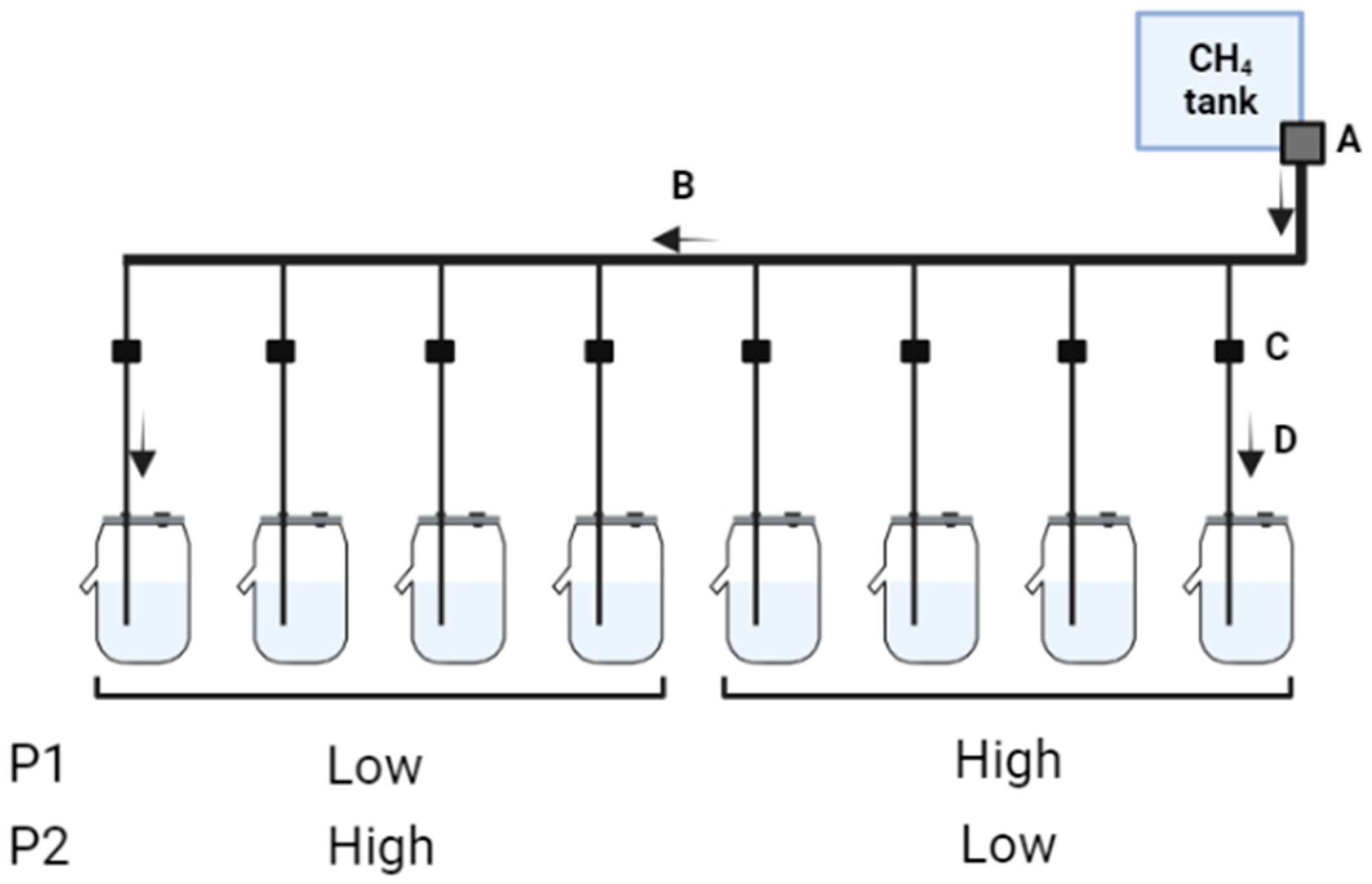


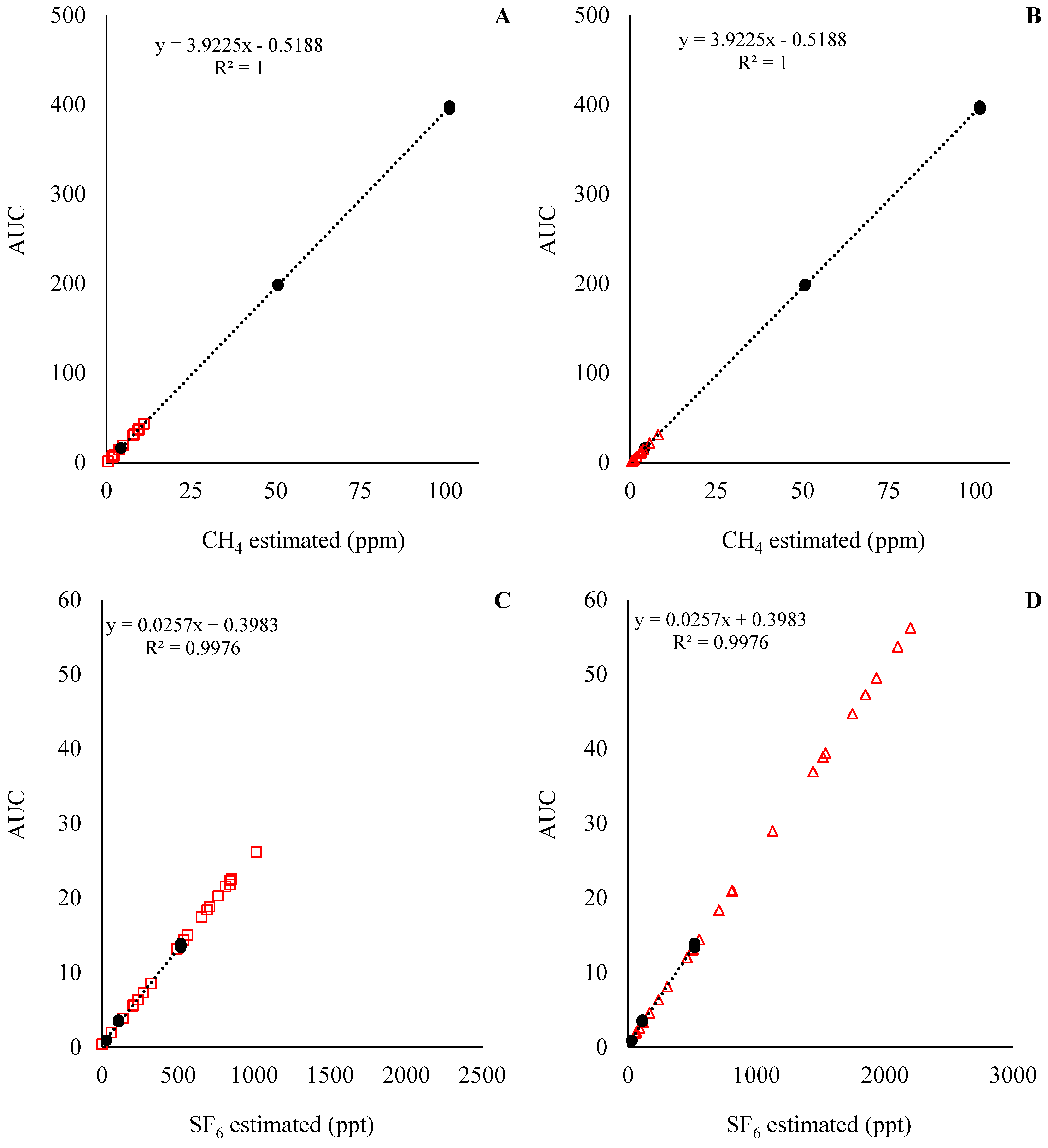
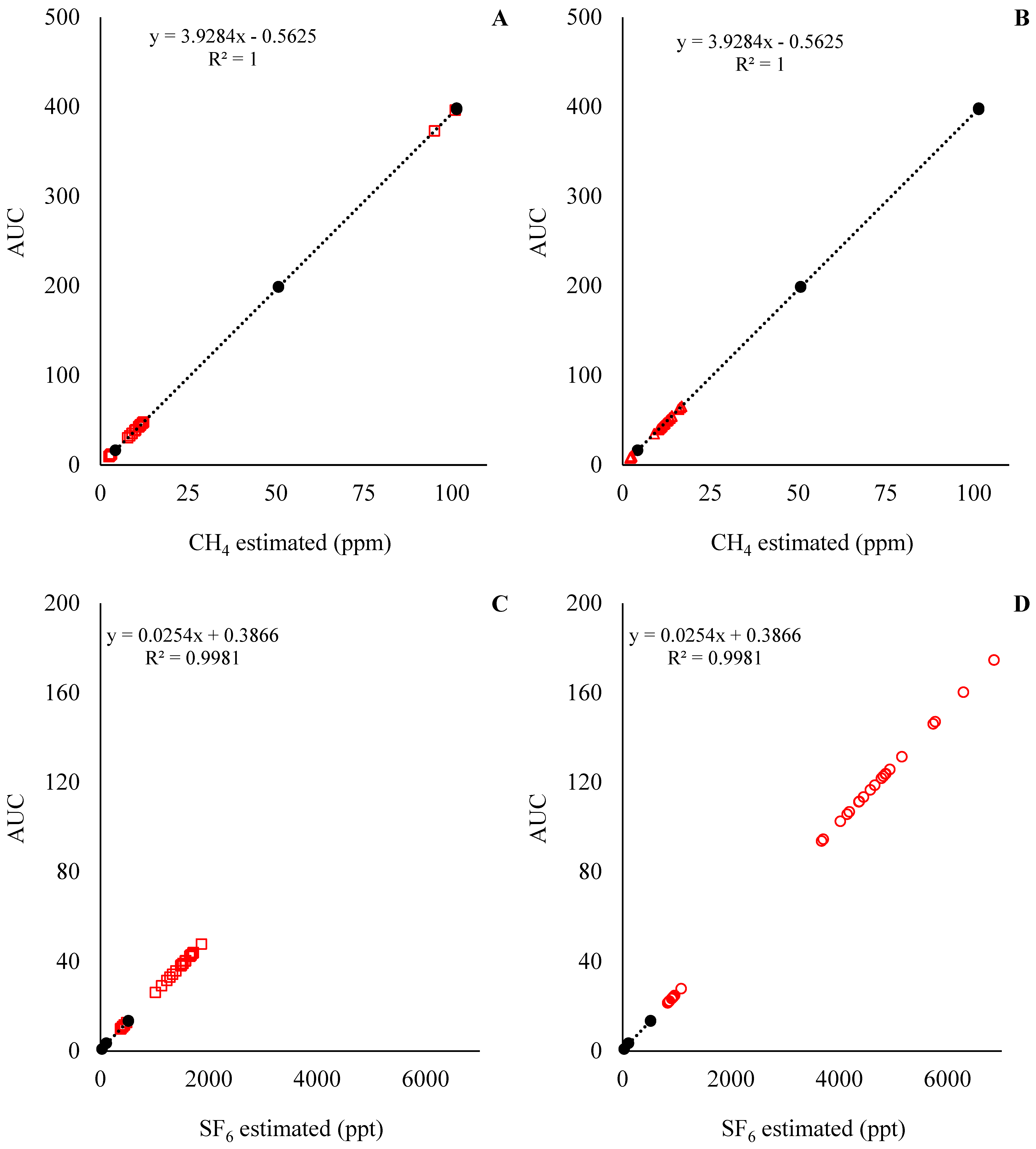
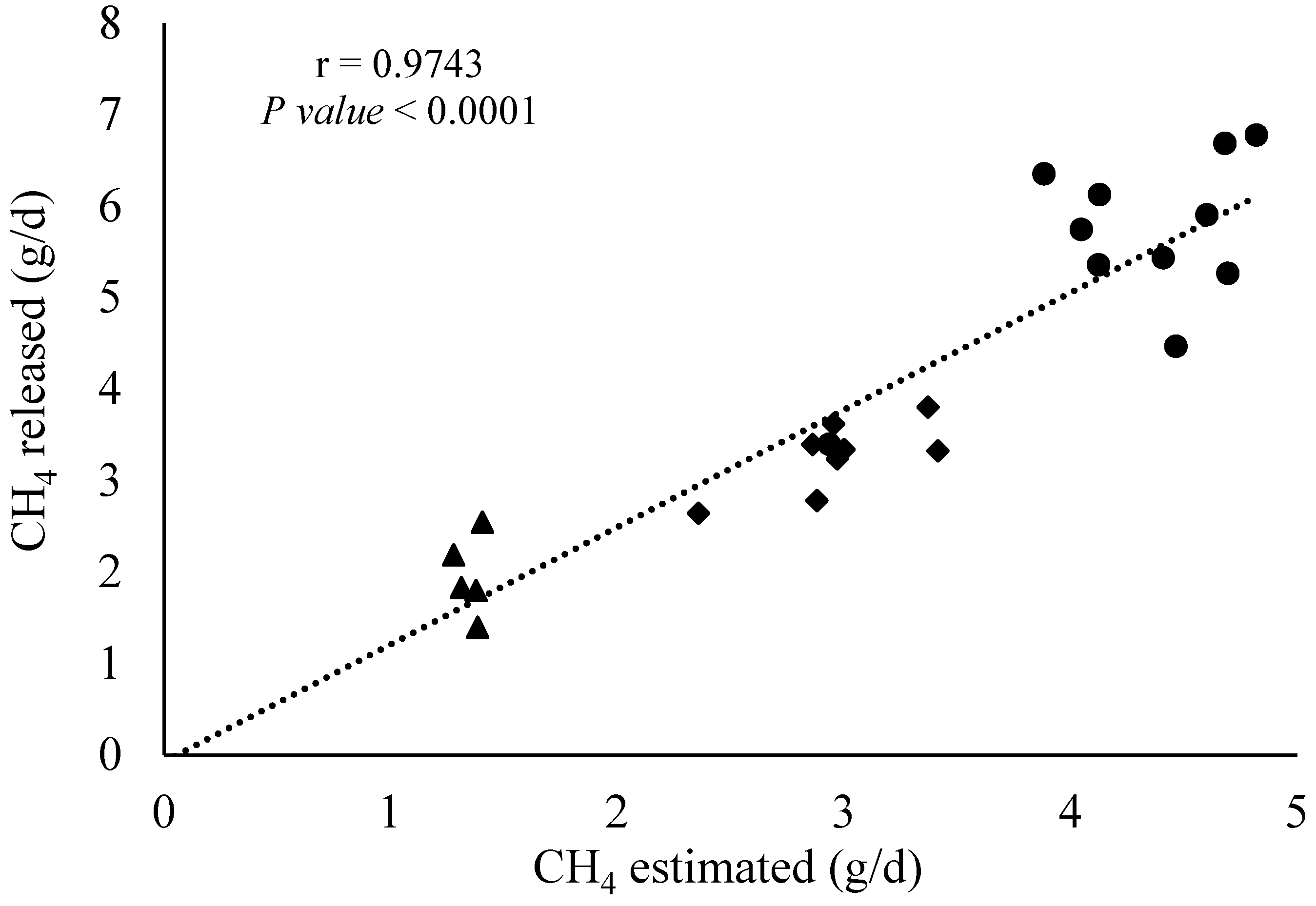

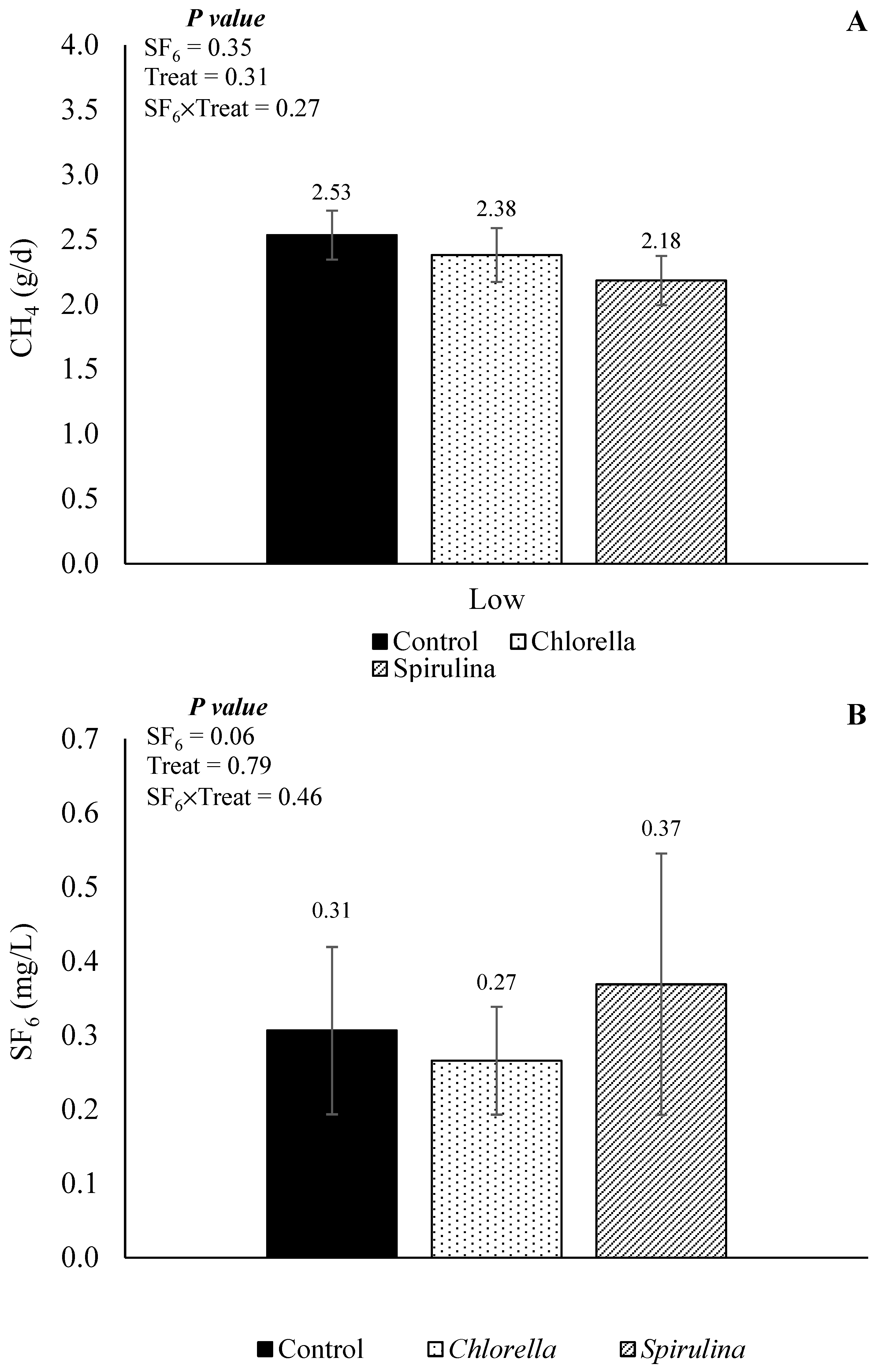
| Treatments 1 | SEM | Contrast p-Value 2 | ||||
|---|---|---|---|---|---|---|
| Control | Chlorella | Spirulina | CRT vs. Algae | CHL vs. SPI | ||
| CH4 production | ||||||
| mg/g DMD | 35.0 | 31.5 | 31.2 | 3.42 | 0.17 | 0.93 |
| mg/g OMD | 41.8 | 39.4 | 37.2 | 4.08 | 0.20 | 0.56 |
| mg/g NDFD | 138 | 107 | 94.2 | 14.6 | <0.001 | 0.20 |
| True degradability of nutrients, g/d | ||||||
| DMD | 72.1 | 73.0 | 68.7 | 2.96 | 0.62 | 0.23 |
| OMD | 60.5 | 59.3 | 57.8 | 2.63 | 0.35 | 0.57 |
| NDFD | 19.3 | 22.4 | 22.8 | 1.76 | <0.01 | 0.78 |
Disclaimer/Publisher’s Note: The statements, opinions and data contained in all publications are solely those of the individual author(s) and contributor(s) and not of MDPI and/or the editor(s). MDPI and/or the editor(s) disclaim responsibility for any injury to people or property resulting from any ideas, methods, instructions or products referred to in the content. |
© 2024 by the authors. Licensee MDPI, Basel, Switzerland. This article is an open access article distributed under the terms and conditions of the Creative Commons Attribution (CC BY) license (https://creativecommons.org/licenses/by/4.0/).
Share and Cite
Lobo, R.R.; Salas-Solis, G.; Vargas, J.; Monteiro, A.; Silva, S.S.d.; Silva, K.; Arce-Cordero, J.; Vyas, D.; DiLorenzo, N.; Sarturi, J.O.; et al. SF6 Tracer Technique to Estimate Methane Emission in a Dual-Flow Continuous Culture System: Test and Application. Fermentation 2024, 10, 394. https://doi.org/10.3390/fermentation10080394
Lobo RR, Salas-Solis G, Vargas J, Monteiro A, Silva SSd, Silva K, Arce-Cordero J, Vyas D, DiLorenzo N, Sarturi JO, et al. SF6 Tracer Technique to Estimate Methane Emission in a Dual-Flow Continuous Culture System: Test and Application. Fermentation. 2024; 10(8):394. https://doi.org/10.3390/fermentation10080394
Chicago/Turabian StyleLobo, Richard R., Gerald Salas-Solis, Juan Vargas, Alyce Monteiro, Sarah S. da Silva, Kaliu Silva, Jose Arce-Cordero, Diwakar Vyas, Nicolas DiLorenzo, Jhones O. Sarturi, and et al. 2024. "SF6 Tracer Technique to Estimate Methane Emission in a Dual-Flow Continuous Culture System: Test and Application" Fermentation 10, no. 8: 394. https://doi.org/10.3390/fermentation10080394
APA StyleLobo, R. R., Salas-Solis, G., Vargas, J., Monteiro, A., Silva, S. S. d., Silva, K., Arce-Cordero, J., Vyas, D., DiLorenzo, N., Sarturi, J. O., & Faciola, A. P. (2024). SF6 Tracer Technique to Estimate Methane Emission in a Dual-Flow Continuous Culture System: Test and Application. Fermentation, 10(8), 394. https://doi.org/10.3390/fermentation10080394





